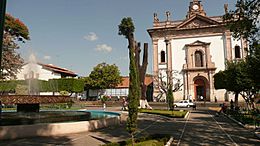Environment facts for kids
Environment is a place where different things are such as a swampy or hot environment. It can be living (biotic) or non-living (abiotic) things. It includes physical, chemical and other natural forces. Living things live in their environment. They constantly interact with it and adapt themselves to conditions in their environment. In the environment there are different interactions between animals, plants, soil, water, and other living and non-living things.
Since everything is part of the environment of something else, the word environment is used to talk about many things. People in different fields of knowledge use the word environment differently. Electromagnetic environment is radio waves and other electromagnetic radiation and magnetic fields. The environment of galaxy refers to conditions of interstellar medium.
In psychology and medicine, a person's environment is the people, physical things and places that the person lives with. The environment affects the growth and development of the person. It affects the person's behavior, body, mind and heart.
Discussions on nature versus nurture are sometimes framed as heredity vs. environment.
The living conditions of living organisms in an environment are affected by the weather or climate changes in the environment.
Natural environment
In biology and ecology, the environment is all of the natural materials and living things, including sunlight. If those things are natural, it is a natural environment.
Environment includes the living and nonliving things that an organism interacts with, or has an effect on it. Living elements that an organism interacts with are known as biotic elements: animals, plants, etc., abiotic elements are non living things which include air, water, sunlight etc. Studying the environment means studying the relationships among these various things. An example of interactions between non-living and living things is plants getting their minerals from the soil and making food using sunlight. Predation, an organism eating another, is an example of interaction between living things.
Some people call themselves environmentalists. They think we must protect the natural environment, to keep it safe. Things in the natural environment that we value are called natural resources. For example; fish, insects, and forests. These are renewable resources because they come back naturally when we use them. Non-renewable resources are important things in the environment that are limited for example, ores and fossil fuels after a few thousand years. Some things in the natural environment can kill people, such as lightning.
- Ecological units which are natural systems without much human interference. These include all vegetation, microorganisms, soil, rocks, atmosphere, and natural events.
- Universal natural resources and physical phenomenon which lack clear-cut boundaries. These include climate, air, water, energy, radiation, electric charge, and magnetism.
Historical environment
A person's environment is the events and culture that the person lived in. Environment is everything around us. A person's beliefs and actions depend on his environment. Modern people mostly think it is wrong to own slaves. But in Jefferson's and Caesar's environments slavery was normal. So, their actions did not look as wrong in their societies. Its simple definition is "interaction between human and environment in the past".
See also
 In Spanish: Medio ambiente (desambiguación) para niños
In Spanish: Medio ambiente (desambiguación) para niños



